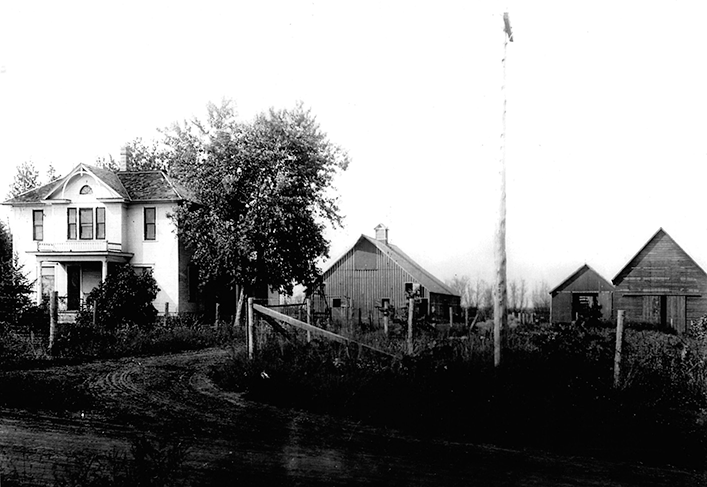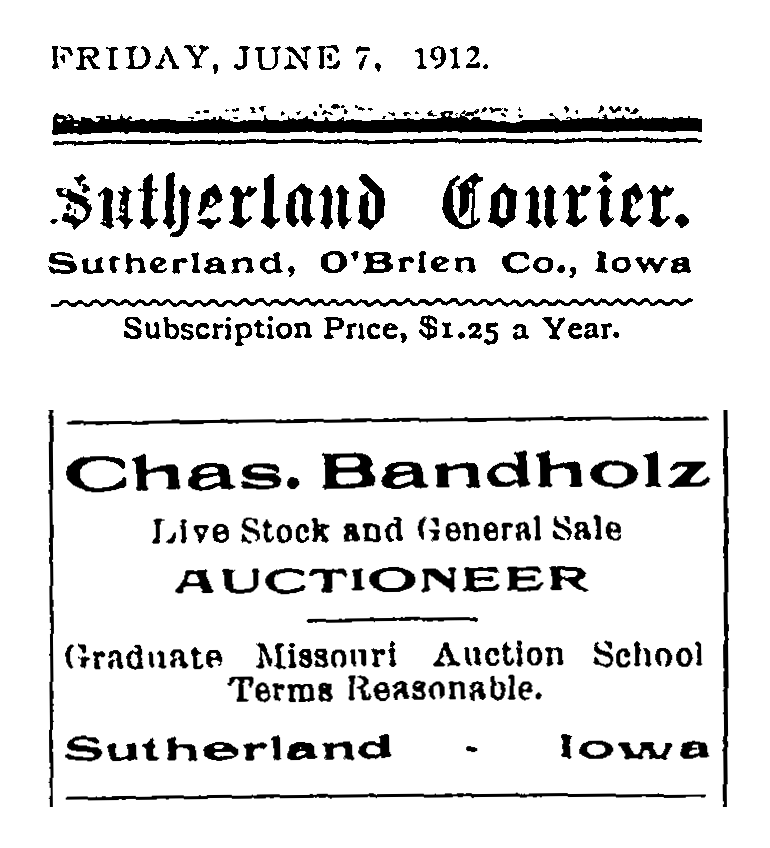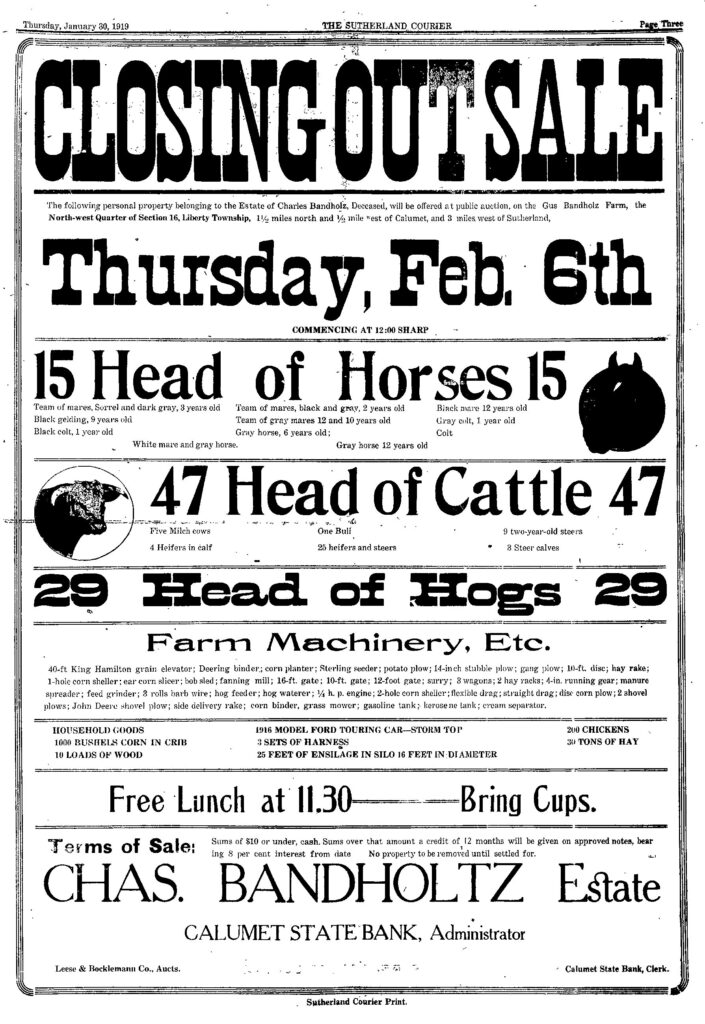
Charles Bandholz, called Charley by his parents, was the son of Gustav “Gus” Marcus Bandholz (1862-1940), who had been born in Schleswig-Holstein, and Ida Marie Schroeder (1868-1932), whose father hailed from the Mecklenburg region of northern Germany.

In a typical migration pattern for German immigrants of this era, Gus and Ida had stopped first in Davenport, Scott County, Iowa, where they were married and where Charles, their first child, was born. Scott County was where the passenger railroad crossed the Mississippi River; Davenport, an important terminus, is sometimes referred to as the “Ellis Island of the Midwest.” Some of the many German families immigrating to the interior U.S. during the last decades of the 19th century stayed in Scott County, and others moved on to central and northwest Iowa, as did the Bandholzes in 1894.
At the time of this June 1909 photo, Charles and his sister Lillian (“Lilly,” 1897-1957) lived with their parents on a farm in the northeast corner of Section 16 of Liberty Township. (A middle child, a son, Rudolph, had died in infancy.)

On 18 December 1912, Charles married Dora Maria Margaretha Menke (1891-1956), who had been born in Hanover in northern Germany. Dora was the daughter of Dietrich “Dick” Menke (1860-1949) and Sophia Margarethe Dorothea Horstmann (1862-1936). The Bandholz family and the large Menke family, who farmed in Section 21 of Liberty Township, were close neighbors, living just two miles apart. (See map.)

Two children quickly followed the marriage of Charles and Dora: Clarence Gustav (1914-1994) and Bernice Sophia Ida (1917-1992). The young family embarked on a typical midwestern life: moving onto and farming the family property, sometimes in lines of succession that continued through generations. Upon the marriage of Charles and Dora, Charles’s parents, Gus and Ida, retired and moved into the town of Sutherland with their daughter Lilly.

In addition to the Bandholzes’ farming life, Charles also worked as an auctioneer, running a standing weekly ad from 1910 to 1914 in the local paper, which stated his credential, “Graduate Missouri Auction School.”
But the happy family life was tragically short-lived.
On 11 January 1919, Charles died at age 30 from the third wave of the great 1918 flu pandemic (sometimes called the “Spanish flu,” a misnomer(1)), leaving 27-year-old Dora with two young children: Clarence, nearly 5 years old, and Bernice, not yet 2. Like his Calumet German Band colleague Newell Bidwell (1896-1918), who had died of the pandemic just 13 weeks previously, Charles fell victim to a worldwide scourge with unusually high mortality for young adults. Between 1918 and 1921, the pandemic infected nearly a third of the global population and killed tens of millions of people, estimated at between 1 and 6 percent of the population overall.

A poignant memento, all too indicative of the toll that the flu took on countless young lives, can be seen in a full-page advertisement, 30 January 1919, in The Sutherland Courier, for a “Closing Out Sale,” to settle the estate of young Charles Bandholz and to immediately turn livestock, farm machinery, and even a 1916 Ford touring car into cash that could sustain his bereaved young family.
Charles had taken ill on January 3, on the family farm where he grew up. He died eight days later — on that very farm. His funeral was two days after that, with the service held also on the farm. And the sale of his worldly goods, down to the teams of mares and the corn planter and the chickens and the cream separator, was held a mere three weeks later — once again on the family farm.
Charles’s widow, Dora, and her two young children were initially taken in by her parents, Dick and Sophia Menke. Later, in 1925, she married Thomas Ludwig Clausen (1893-1988), another German immigrant who had been born in Schleswig-Holstein. Upon Dora’s death in 1956, Clausen also remarried, in 1959, to Elsabe (Elisabeth) Nissen Karstens(2) (1901-1988), herself a widow, who died eight months before Clausen’s own death.
Charles Bandholz and Dora Menke Bandholz are buried in Waterman Cemetery in Sutherland.

Subscribers to Ancestry.com may wish to further explore some family connections of Charles Bandholz by accessing an Ancestry profile page (within the context of a “Mugge Family Tree”).
Connection to Other Band Members
At the time of this photo, June 1909, Charles is not known to be related to other band members. But when Charles married Dora in December 1912, the marriage started a chain of complex relationships.
Dora’s brother Ernest Menke (1887-1969) had already married the sister of Charles’s bandmate Henry W. Mugge (1891-1967), Clara Margaretta Sophie Mugge (1890-1985), in March 1910. (See a photo of this family.)
A little more than two years after Charles and Dora’s 1912 marriage, in February 1915, Dora’s sister “Minnie” (Treugina Wilhelmine Menke, 1893-1992) married Herman John Friedrichsen (1891-1979), a brother of bandmate Henry Friedrichsen (1889-1937). Although Charles died in January 1919, later in that year, in October, Dora’s sister Anna Sophie Menke (1897-1935) married Elmer Henry Mugge (1895-1968), another sibling of his bandmate Henry Mugge.
Through the in-law connection with bandmate Henry Friedrichsen, Charles Bandholz would also become related to his bandmate Herman F. Steinbeck (1889-1958), who in November 1914 would become the brother-in-law of Henry Friedrichsen when Friedrichsen married Steinbeck’s sister Emma.
These multiple connections may be best understood with the aid of a schematic, available here.
Finally, through more distant marriage connections, Charles Bandholz can be tangentially linked to fully half of the band.(3)
Connection to the Mugges
There are close and numerous connections — family, friends, neighbors — between Charles Bandholz and the Mugge family. The following information provides further detail than that provided above.
One of the many siblings of Charles’s wife, Dora Menke, was Ernest Menke (1887-1969), who in March 1910 married Clara Margaretta Sophie Mugge (1890-1985), eldest child of Johann H. Mugge (1865-1931) and Bertha Henrietta Dora Steffens (1868-1946). (See photo.) Clara and Ernest’s children were Neva, who died in infancy, and Lester Dietrich Herman Menke (1918-2016).
Another of Dora’s siblings was Anna Sophie Menke (1897-1935), who married the younger brother of Clara Mugge and Henry Mugge, Elmer Henry Mugge (1895-1968). (See photo.) That marriage, in October 1919, produced Harold Herman Richard (1920-2000), Dalton Ernest (1921-2021), Mae Sophie (1924-2010), and Arlo William (“Ozzie”) (1925-2022). (See the Henry Andersen bio page for yet another connection, between Dalton Mugge and Henry Andersen.)
Still another sibling in the Menke family was Treugina Wilhelmine “Minnie” Menke (1893-1992), who married Herman Friedrichsen (1891-1979) — brother of band member Henry Friedrichsen. There were two sons from this February 1915 marriage: Elmer Wilhelm Dietrich (1916-1998) and Delbert William (1923-1981).
Thus, the Mugges, Menkes, Friedrichsens, and Bandholzes are all related through marriages between 1910 and 1919. Among these, the marriages of a sister and brother in one family (Clara and Elmer Mugge) to a brother and sister in another (Ernest and Anna Menke) produced double-cousin relationships.
Note also that the Bandholz family farm was directly across the road from the farm of Henry J. Schallau (1874-1934) and Rosa Brecht (1871-1950) (see 1911 plat map), which beginning in 1952 was farmed by the family of Lyle John Mugge (1915-2000) and since 1976 by Lyle’s son Paul Henry Mugge (b. 1951) and family.
Unrelated to this photo, through the Bandholz–Mugge connection, Charles Bandholz was also related by marriage to Frances Catheryn Schimmer (1892-1919), who was the first wife of Harry Dietrich Mugge (1893-1956) (see photo), the third of Hermann and Bertha’s 10 children and brother of Henry W. Mugge. Frances was also connected to the Henry Mugge family in a second way: she and Henry Mugge’s wife Lillie Kundel (1892-1960) were first cousins, in that Frances’s mother, Caroline Rohwer (1869-1953) (wife of John Peter Schimmer, 1866-1941), and Lillie Kundel’s mother, Dorothea “Dora” Rohwer (1862-1932) (wife of John Claus Kundel, 1959-1934), were sisters. Their parents were Claus Rohwer (1832-1904) and Frauke (Francis) Bock (1837-1888). These two connections are displayed on a schematic, available here, for ease of comprehension.
Like Charles Bandholz, Frances Schimmer Mugge also succumbed to the “Spanish flu.” In a sad coincidence, Charles and Frances died on the very same day, 11 January 1919, within only a few hours of each other. Just as Charles’s death had left behind a young wife and children, the too-early death of Frances (26 years old) left her husband with three young children, too young to remember their mother: Clarence (age 3 and a half), Gladys (age 2), and Delbert (just 10 months). (Many years later, Gladys Mugge’s marriage, in 1936, produced a separate connection with band member Henry Jacob Lorenzen, as explained on his page.) Following Frances Schimmer Mugge’s death, Harry Mugge later married Viola Ida Withoelter (1908-1980), in 1928.
Footnotes
(1) As noted also in the biosketch for Newell Bidwell, the great 1918 flu pandemic was called the “Spanish flu” due to a misunderstanding about its origins. Epidemiologists are uncertain about where the disease actually arose. When the flu broke out in the final years of the war, some of the belligerent nations enforced censorship of the news in an attempt to contain panic. But newspapers in Spain, which was a neutral country, were among the first to report on the outbreak, thus leading to a common yet incorrect assumption about origin. (Today epidemiologists and public health authorities reject geographic labels for diseases altogether in order to prevent stigma.) The 1918 pandemic was caused by the H1N1 influenza A virus that has also been the source of other pandemics, most recently in 2009.
(2) In yet another indication of the small world of Calumet and its environs, Elisabeth’s first husband was John Karstens (1875-1957), who like several other band members’ families owned a farm in Liberty Township (in Section 19, in the western part of the township). The Karstens family had two daughters, Bessie and Alice.
(3) These additional connections would be with Henry Andersen, Newell Bidwell, John Brumm, Nick Jessen, Ralph Langley, Henry Lorenzen, Albert Mehrens, John Mehrens, Charley Rochel, Harry Rochel, Ernest Shafer, William Shafer, and Allie Sohm. Readers who seek more information about these connections (some of them quite complex) may wish to contact John Mugge by using the Contact form, available here.

